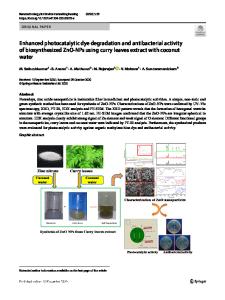Rapid photocatalytic degradation of RhB dye and photocatalytic hydrogen production on novel curcumin/SnO 2 nanocomposite
- PDF / 2,309,154 Bytes
- 16 Pages / 595.276 x 790.866 pts Page_size
- 101 Downloads / 362 Views
Rapid photocatalytic degradation of RhB dye and photocatalytic hydrogen production on novel curcumin/SnO2 nanocomposites through direct Z-scheme mechanism M. A. Ahmed1,*
1 2
, Nabil Al-Zaqri2, Ali Alsalme2, A. H. Glal1, and Mahmood Esa1
Chemistry Department, Faculty of Science, Ain Shams University, Cairo, Egypt Department of Chemistry, College of Science, King Saud University, P.O. Box 2455, Riyadh 11451, Saudi Arabia
Received: 23 April 2020
ABSTRACT
Accepted: 7 September 2020
For a first time, curcumin/SnO2 nanocomposites were synthesized by combined sol–gel assisted ultrasonic route for photocatalytic degradation of RhB dye and hydrogen production. The as-synthesized novel nanoparticles were systematically characterized by XRD, N2-adsorption–desorption isotherm, DRS, PL, XPS, and HRTEM. Surprisingly, the color of the nanocomposite turned reddish yellow upon incorporation of curcumin which taken as evidence for charge transfer complex between SnO2 and curcumin. Particularly, a reduction in XRD and PL intensity reflect the strong chemical interaction between SnO2 and curcumin. The as-achieved curcumin/SnO2 nanocomposites exhibits an excellent photoreactivity and stability toward degradation of RhB dye with optimal concentration 5 wt% curcumin for removal 95% of RhB dye on 0.5 g/l photocatalyst in 120-min under visible light radiations compared with 38% removal on bare SnO2 under the same reaction conditions. The amount of hydrogen evolved reaches 15 mmol h-1 g-1 on the optimized sample compared with 3 mmol g-1 h-1 on bare single oxide. The excellent photocatalytic reactivity was attributed to the charge migration through Z-scheme mechanism in which holes and electrons in the inferior energy levels are recombine, however, those at higher energy level are maintained with strong oxidizing and reducing power. This novel Z-scheme mechanism not only enhances the oxidation and reduction efficiency of the photogenerated holes and electrons, but also, improve the quantum efficiency of electron–hole separation. This research will open a door for synthesis new nanocomposite for renewable energy source and wastewater treatment.
Ó
Springer Science+Business
Media, LLC, part of Springer Nature 2020
Address correspondence to E-mail: [email protected]
https://doi.org/10.1007/s10854-020-04455-8
J Mater Sci: Mater Electron
1 Introduction Photocatalysis is green technology for wastewater treatment and production of hydrogen gas as alternative renewable energy source. Industrial water prone to pollution with organic dyes and pigments that cause serious environmental problems [1–4]. The traditional technology for removal of these toxic pollutants are slow, highly cost and accompanied by transformation of the primary pollutants into secondary one [5–8]. The production of large number of reactive radicals through a photocatalytic process is a green route for destruction of organic pollutants upon exposure of semiconductor to visible light [9–12]. Recently, various semiconductors are involved in wastewater treatment [1
Data Loading...











